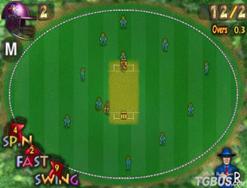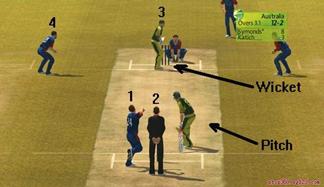

Cricket
About the game:
Cricket is a game played between two teams, generally of 11 members each. Essentially, it is single combat, in which an individual batsman does battle against an individual bowler, who has helpers known as fielders. The bowler throws the ball from one end of the 22-yard pitch in an attempt to dismiss (send out) the batsman by hitting a target known as the wicket at the other end, or by causing the batsman to hit the ball into the air into a fielder's grasp. The batsman attempts to defend the wicket with the bat and to score runs, by striking the ball to the field boundary, or far enough from the fielders to allow the batsman to run to the other end of the pitch before the ball can be returned. There are always two batsmen on the field, each to take a turn as required. When all but one of the batting team, altogether eleven of them, have been dismissed, the teams' roles are switched. After all the players required to bat on both sides have done so either once or twice (which can take from a few hours to five days) the total number of runs accumulated determines the winner. But sometimes there isn't one.
Important terms of cricket:
Batsman: A player who uses a bat to hit, or guide the ball after it has been bowled, usually for the purpose of scoring runs.
Boundary: Indicates the outer limit of the playing area.
Bowler: Refers to a player who’s primarily good at throwing a ball to a batsman. The basic goal is to get the ball past the batsman and break the wicket behind him with it and thus cause the batsman to be dismissed.
Catch: If a fieldsman catches a struck ball before it touches the ground, that is a catch and the batsman is out.
Fielder: A player placed within the field, with the object of stopping the batting team from scoring runs, also called “fieldsman”.
Four: If the ball is hit to bounce or roll over the boundary, this is a "boundary four"; four runs are added.
Run: The method of scoring during a game of cricket. Also refers to a single unit of score.
Six: If the batsman hits the ball clear over the boundary on the fly, six runs are added to the score.
Umpire: A person appointed to rule on plays in cricket.
64. What’s the right order of the four kinds of people (1—4 ) on the cricket ground (see picture on the right ) ?
A. bowler; umpire; batsman; fielder B. batsman; umpire; fielder; bowler
C. fielder; bowler; batsman; umpire D. bowler; umpire; fielder; batsman
65. What happens when the batsman hits the ball, which first touches the ground inside the pitch and rolls quickly over the boundary to one of the viewers outside the cricket ground?
A. The batsman gets dismissed. B. The batting side gets four runs.
C. The batting team gets six runs. D. The bowler’s team gets four runs.
66. We can learn from the passage that ________.
A. the side which has all its batsmen dismissed wins the game
B. the side which dismisses all batsmen of the other side wins the game
C. the side which gets more runs than the other side wins the game
D. the side which dismisses more of the other side’s batsmen wins the game